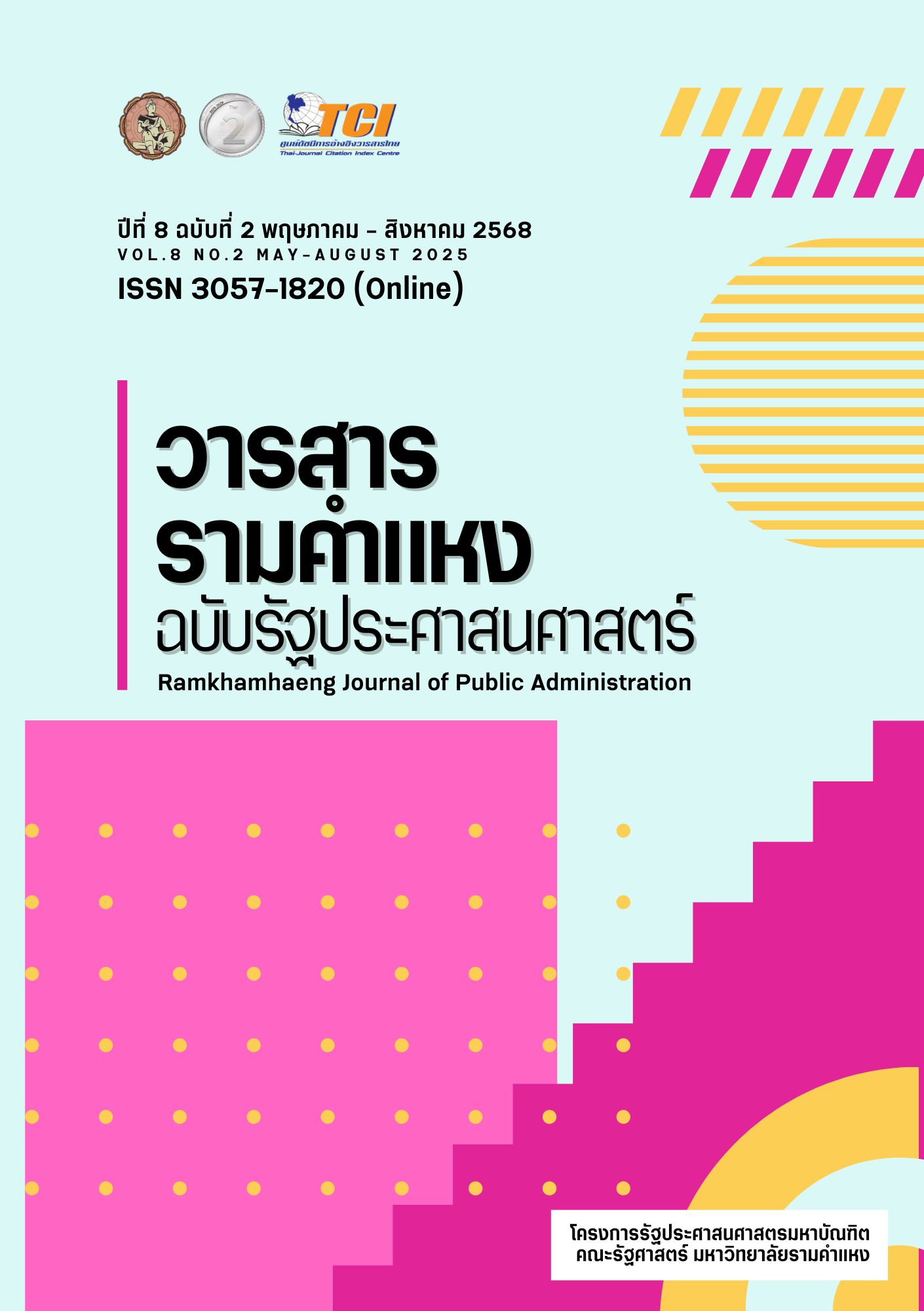The historical dynamics of the economy, as demonstrated by the two fluctuating prices of rubber in the world market
Keywords:
Rubber Price Turning Point, Combustion Engine, Colonial Power, Siam Nation StateAbstract
The economic history development since the end of 19th Century has been marked by a trend of increasing agricultural production. This transformation has led to the conversion of vast areas of rainforest in Southeast Asia into farmland for growing rubber, with the objective to make it a key raw material for the automotive industries in Europe and the United States. The use of land in the British Malayan Colony, the Dutch Colony of Indonesia, and the French colony of Indochina in South Vietnam and Cambodia was instrumental in cultivating rubber as a raw material for the automobile industry. From the late 19th century to the early 20th century, millions of rai of rubber were grown to meet the industry's demand for large quantities of rubber raw materials. The peak price of rubber occurred in 1910, prior to the commencement of World War I. As a result, there was a significant expansion in rubber plantations and the supply of rubber. Agriculture, particularly the cultivation of commercial crops, became the most significant economic commodity in the history of Southeast Asia. From 1910 to 2011, the period of economic development in history spanned for 101 years. During this time, the price of rubber reached its highest level once again in 2011. This rise in the price of rubber can be attributed to the China Economic Miracle, which led to the country's economic growth and subsequently impacted the world market. The rise in rubber prices in 2011 resulted in another major expansion of rubber supply in Asia in the 21st century. Land is being used for growing rubber in new areas in the northern and northeastern regions of Thailand, southern China, Laos, Cambodia, Myanmar and Vietnam. Approximately 7 million rai of rubber plantations are available as a raw rubber supply source. Providing for the needs of the automobile industry in the 21st century with China being the world's largest consumer.
References
กรมสงเสริมสหกรณ์. (2538). การศึกษาภาวะการผลิตและการตลาดยางพารา สหกรณ์กองทุนสวนยางปี 2538. ผู้แต่ง.
การยางแห่งประเทศไทย. (2567). ราคายางและข้อมูลสถิติราคายางพารา 2544-2576. เรียกใช้เมื่อ 27 กรกฎาคม 2567 จาก https://www.raot.co.th/rubber2012/menu5.php.
ภูวดล ทรงประเสริฐ. (2535). ทุนสิงคโปร์: การผูกขาดตลาดยางพาราและดีบุกไทย. สถาบันเอเซียศึกษา จุฬาลงกรณ์มหาวิทยาลัย.
ยศ สันตสมบัติ,อรัญญา ศิริผล. (2556). ยางพาราในลุ่มน้ำโขง การปรับตัวของชุมชนท้องถิ่นในลาว กัมพูชา และไทย . คณะสังคมศาสตร์ มหาวิทยาลัยเชียงใหม่.
ยุทธิยง ลิ้มเลิศวาที ณรงค์ เพ็ชรประเสริฐ. (2566). อำนาจของอังกฤษในการควบคุมจำกัดอุปทานยางกับความขัดแย้งผลประโยชน์รถยนต์สหรัฐอเมริกาหลังสงครามโลกครั้งที่1. วารสารรามคำแหงฉบับรัฐประศาสนศาสตร์ ปีที่ 6 ฉ.3.
ยุทธิยง ลิ้มเลิศวาที ณรงค์ เพ็ชรประเสริฐ. (2567). การเคลื่อนย้ายศูนย์กลางการผลิตยางธรรมชาติจากบราซิลเข้าสู่สิงคโปร์และแหลมมาลายูในศตวรรที่19. วารสารมนุษยศาสตรและสังคมศาสตร มหาวิทยาลัยราชภัฏสงขลา ปีที่ 6 ฉ.1.
รังสรรค์ ธนะพรพันธ์. (2530). สถิติการค้าระหว่างประเทศ เอกสารการบรรยายเศรษฐกิจไทย 2475-2503. คณะเศรษฐศาสตร์ มหาวิทยาลัยธรรมศาสตร์.
สำนักงานเศรษฐกิจการเกษตร. (2565). ข้อมูลรายละเอียดพื้นที่การปลูกยาง รายภาคของประเทศไทยปี2565. เรียกใช้เมื่อ 14 กรกฏาคม 2567 จาก https://www.oae.go.th/assets/portals/1/fileups/prcaidata/files/para%20rubber%2065.pdf.
สุธัญญา ทองรักษ์. (2546). โครงการวิจัยเรื่อง วิวัฒนาการการใช้ที่ดินและป่าไม้บริเวณลุ่มทะเลสาปสงขลาปี 2442-2489. สำนักงานคณะกรรมการส่งเสริมวิทยาศาสตร์ วิจัยและนวัตกรรม.
สุธิวงศ์ พงศ์ไพบูลย์และคณะ. (2540). จีนทักษิณ วิถีและพลัง. กรุงเทพฯ: สำนักงานกองทุนสนับสนุนการวิจัย (สกว).
The Rubber Economist Ltd. (1985). Natural rubber prices in New York and London 1825-. Retrieved from https://www.therubbereconomist.com/NR_prices.html.
Ford Motor Company unveils the Model T. (2010). Retrieved July 6, 2024, from https://www.history.com/topics/inventions/model-t.
Art, J. L. (2015). 50 Great Peranakans : Lim Nee Soon. Retrieved July 10, 2024, from https://jenniferlimart.com/blog/2015/5/25/50-great-peranakans-mr-lim-nee-soon.
Berto, F. J. (2024). Article History Bicycle. Retrieved July 8, 2024, from Encyclopaedia Britannica.
D.G.H. Hall, ชาญวิทย์ เกษตรศิริ บรรณาธิการ. (1970). ประวัติศาสตร์เอเชียตะวันออกเฉียงใต้ (เล่มที่2). มูลนิธิโครงการตำราสังคมศาสตร์และมนุษยศาสตร์.
FAO. (1999). Rubber plantations. Retrieved July 13, 2024, from https://www.fao.org/4/Y0153E/Y0153E05.htm.
Fircroft, N. (2021). A Brief History Of German Automotive Engineering. Retrieved July 6, 2024, from https://www.nesfircroft.com/resources/blog/a-brief-history-of-german-automotive-engineering/.
Fircroft, N. (2021). A Brief History Of German Automotive Engineering. Retrieved July 7, 2024, from https://www.nesfircroft.com/resources/blog/a-brief-history-of-german-automotive-engineering/.
Ghee, L. T. (1971). Peasants and their Agricultural in Colonial Malaya 1874-1941. Australian National University.
Gliech, O. (2015). Rubber International Encyclopedia of The First World War. Retrieved July 7, 2024, from https://encyclopedia.1914-1918-online.net/article/rubber.
Huide Huang, Haolun Huang. (2018). Analysis of Rubber in Malaysia. Asian Agricultural Research.
Jackson, D. D. (2023). American Automobile Industry World War One Era Motor Vehicles. Retrieved July 8, 2024, from https://usautoindustryworldwartwo.com/worldwaronemotorvehicles.htm.
James Hagan, Andrew Wells. (2005). The British and Rubber in Malaya c1890-1940. University of Wollongong Research Online. Retrieved July 12, 2024
Jefferson Metz Fox,Jean-Christophe Castella. (2013). Expansion of Rubber in Mainland Southeast Asia: What are the Prospects for Small Holders? The Journal of Peasant Studies. Retrieved July 14, 2024
Loh Pei Ying and Heleena Panicker. (2023). Rubber, Race, and Colonial Exploitation. Retrieved July 7, 2024, from https://kontinentalist.com/stories/rubber-race-and-colonial-exploitation.
Micheaux, E. L. (2022). British Malayan capitalism, 1874–1957. Retrieved July 6, 2024, from https://hal.science/hal-04030948/document.
OKTORA, Siskarossa Ika. (2019). Natural Rubber Economics between China and Southeast Asia: The Impact of China's Economic Slowdown. The Journal of Asian Finance, Economics and Business. Retrieved July 14, 2024
Thailand Board Investment. (2015). Thailand Rubber Industry. Retrieved July 13, 2024, from https://www.boi.go.th/upload/content/Rubber_5a3b80bcc4882.pdf.
The Rubber Economist Ltd. (1985). Natural rubber prices in New York and London 1825-. Retrieved July 12, 2024, from https://www.therubbereconomist.com/NR_prices.html.
wikipedia. (2024). Retrieved July 7, 2024, from The Michelin Rubber Plantation in Vietnam.
Downloads
Published
How to Cite
License
Copyright (c) 2024 ยุทธิยง ลิ้มเลิศวาที, ณรงค์ เพ็ชรประเสริฐ

This work is licensed under a Creative Commons Attribution-NonCommercial-NoDerivatives 4.0 International License.



